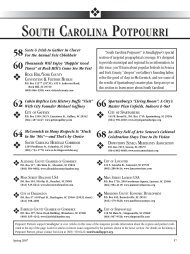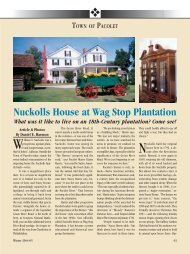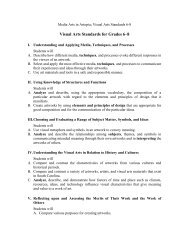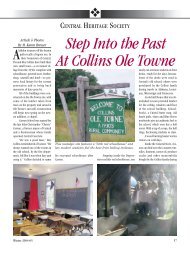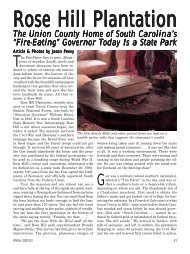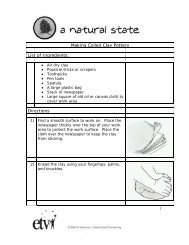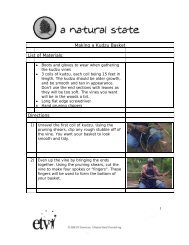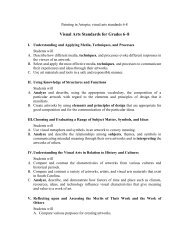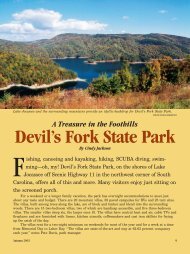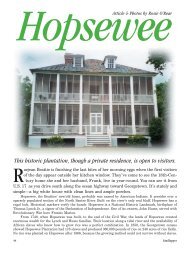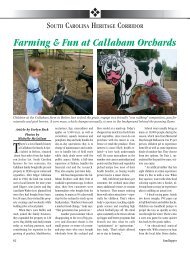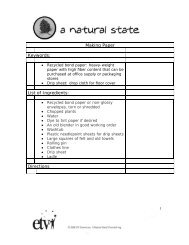The Case Of The Physical Fitness Challenge - Knowitall.org
The Case Of The Physical Fitness Challenge - Knowitall.org
The Case Of The Physical Fitness Challenge - Knowitall.org
Create successful ePaper yourself
Turn your PDF publications into a flip-book with our unique Google optimized e-Paper software.
Pumping Up the Stress<br />
2005–2006 NASA SCI Files Series<br />
http://scifiles.larc.nasa.gov<br />
EG-2005-10-09-LARC <strong>The</strong> <strong>Case</strong> of the <strong>Physical</strong> <strong>Fitness</strong> <strong>Challenge</strong><br />
21<br />
Segment 1<br />
Purpose<br />
To discover how the heart pumps blood throughout the body<br />
Materials<br />
To prove that the more active a person is, the more the heart works to supply blood to the body bicycle tire pump<br />
To locate your pulse points and calculate your heart rate<br />
1 m of rubber tubing<br />
2 funnels<br />
Background<br />
masking tape<br />
timer (stopwatch or clock<br />
<strong>The</strong> heart is a muscle in your body. It is located slightly to the left of the middle of your chest<br />
and is about the size of your fist. <strong>The</strong> heart’s job is to send blood throughout your body. Blood with second hand)<br />
gives your body the oxygen and nutrients it needs and carries away waste products. <strong>The</strong> heart Heart Stress Test chart<br />
is like a double pump. <strong>The</strong> right side of the heart receives the oxygen depleted blood from<br />
(p. 23)<br />
the body and pumps it to the lungs. <strong>The</strong> left side of the heart receives the oxygen rich blood pen or pencil<br />
from the lungs and pumps it to the body. It takes your heart less than 60 seconds to pump<br />
colored pencils<br />
blood to every cell in your body. As your heart pumps, valves inside your heart open and close.<br />
This opening and closing makes a distinct sound known as your “heartbeat.” You can hear the<br />
science journal<br />
heartbeat by using a stethoscope, a medical tool used to hear sounds within the body. Your<br />
heart will beat slower when your body is at rest and faster when it is active. This increase in<br />
heartbeat occurs because the more active you are, the more oxygen rich blood your body needs. Your<br />
heart must pump faster to accommodate the increase in need. Your heart rate is the number of times the<br />
heart beats per minute.<br />
Aerobic activities are designed to make your heart beat faster and increase the amount of oxygen in the<br />
blood. According to the Center for Disease Control (CDC), aerobic activities improve the function of the<br />
heart, may help lower blood pressure, help control weight, and increase a person’s overall feeling of wellbeing.<br />
Procedure<br />
1. To demonstrate the pumping action of the heart, pull the handle up on the<br />
bicycle tire pump and push it down. Repeat several times and feel the air that is<br />
pumped through the hose.<br />
2. Think about how this pump is similar to a heart. Instead of pumping air, the<br />
heart pushes blood throughout the body. In your science journal, describe how<br />
you think the heart works.<br />
3. To listen to the sound your heart makes as it works, make a simple stethoscope.<br />
a. Attach a funnel to one end of the rubber tubing with masking tape.<br />
b. Repeat and attach the second funnel to the other end of the rubber tubing. See diagram 1.<br />
4. Sit still for about 3 minutes in a quiet location.<br />
5. Tightly hold one funnel up to your ear.<br />
6. Hold the other funnel up to your heart or a partner’s heart (remember the heart is located<br />
slightly to the left of the middle of your chest).<br />
7. While continuing to sit, listen carefully until you hear the sound of the heart beating.<br />
See diagram 2.<br />
8. Using the timer, count the number of heartbeats in 10 seconds. Record the number in your<br />
science journal.<br />
9. To find the number of beats per minute, multiply the number of beats in 10 seconds by 6. Record the<br />
answer in the Heart Stress Test chart for Trial 1. Note: Another way for older students to find a pulse is to<br />
locate the pulse in the inner wrist, neck, or temple and to place two fingers over the pulse. As they feel the<br />
pulse beat, they can count the number of beats for 15 seconds and multiply by four.<br />
10. Repeat steps 5–9 for two more trials. See diagram 3.<br />
11. Find the average of the three numbers and record it in the chart. This number is your average sitting heart<br />
rate.<br />
funnel<br />
tape<br />
toothpick<br />
rubber tubing<br />
tape<br />
yarn<br />
funnel<br />
toothpick is picking the yarn<br />
apart into strings<br />
string muscle<br />
Diagram 1<br />
Diagram 2



